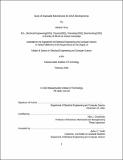| dc.contributor.advisor | Alan J. Grodzinsky. | en_US |
| dc.contributor.author | Timp, Winston (Winston G.) | en_US |
| dc.contributor.other | Massachusetts Institute of Technology. Dept. of Electrical Engineering and Computer Science. | en_US |
| dc.date.accessioned | 2006-06-20T12:53:46Z | |
| dc.date.available | 2006-06-20T12:53:46Z | |
| dc.date.copyright | 2003 | en_US |
| dc.date.issued | 2005 | en_US |
| dc.identifier.uri | http://hdl.handle.net/1721.1/33175 | |
| dc.description | Thesis (S.M.)--Massachusetts Institute of Technology, Dept. of Electrical Engineering and Computer Science, September 2005. | en_US |
| dc.description | This electronic version was submitted by the student author. The certified thesis is available in the Institute Archives and Special Collections. | en_US |
| dc.description | Includes bibliographical references (p. [77]-[79]). | en_US |
| dc.description.abstract | A study was undertaken to determine if a microfluidic chip, made of economical plastic materials, is feasible. The chip was designed to perform gel electrophoresis, specifically of DNA fragments for either sequencing or identification purposes. With a disposable version of such a chip, constraints on the gel type are relaxed and lifetime issues become nonexistent. Such a chip was created using polydimethylsiloxane(PDMS) as the plastic material, with a cast molding process. The chip was subsequently sealed against a piece of PDMS, mounted on a glass slide for structural support. Fluidic and electrical interconnects were added to the chip. A polyacrylarnide solution was injected into the chip for use in DNA separations. The chip was then placed into an apparatus designed for laser induced fluorescence(LIF) detection. Several different samples were run on the chip, including polystyrene beads, organic dye molecules, and single tandem repeat (STR) allelic ladders. The chip demonstrated its electrophoretic efficiency, evincing a low, almost negligible amount of electroosmotic flow. The separation of the dye and DNA was accomplished with good fidelity, allowing for identification of the various substitutents of the loaded sample. | en_US |
| dc.description.abstract | (cont.) The PDMS chip, though demonstrably efficient at DNA separation, needs work before it can move out of the prototype phase. Substantial work on the fluidic interconnection, as well as the basic plastic formulation is needed to move this idea forward. However, the chip is sufficient for a clear proof of the principle of disposable chips use in electrophoretic separations. | en_US |
| dc.description.statementofresponsibility | by Winston Timp. | en_US |
| dc.format.extent | 76, [3] p. | en_US |
| dc.format.extent | 671906 bytes | |
| dc.format.extent | 673528 bytes | |
| dc.format.mimetype | application/pdf | |
| dc.format.mimetype | application/pdf | |
| dc.language.iso | eng | en_US |
| dc.publisher | Massachusetts Institute of Technology | en_US |
| dc.rights | M.I.T. theses are protected by copyright. They may be viewed from this source for any purpose, but reproduction or distribution in any format is prohibited without written permission. See provided URL for inquiries about permission. | en_US |
| dc.rights.uri | http://dspace.mit.edu/handle/1721.1/7582 | |
| dc.subject | Electrical Engineering and Computer Science. | en_US |
| dc.title | Study of disposable microdevices for DNA electrophoresis | en_US |
| dc.type | Thesis | en_US |
| dc.description.degree | S.M. | en_US |
| dc.contributor.department | Massachusetts Institute of Technology. Department of Electrical Engineering and Computer Science | |
| dc.identifier.oclc | 65189004 | en_US |
